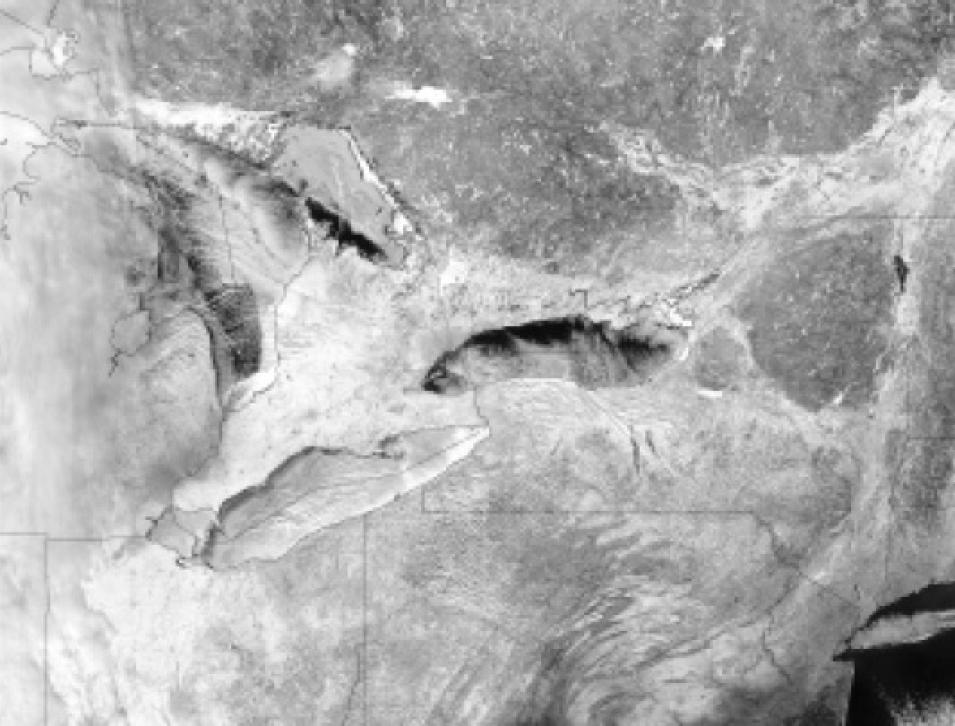While looking closely at the ice, Nghiem and Leshkevich noticed something else. “What we’ve noticed on Lake Superior during March is that 1997 was probably the last year where you had extensive ice cover of good quality. By ‘good quality,’ I mean the ice is not noticeably decaying, the ice is thick, the ice covers more of the lake,” Nghiem said. “It seems that since 1998, we’ve had below-normal ice cover, with the exception of 2003.”
Leshkevich agreed. “As we went across Lake Superior on the Mackinaw in mid-March 2003, the ice just seemed to be more in a state of decay. Even though the coverage was more extensive that winter, the ice cover wasn’t the same quality. It had water on it and holes in it that were probably caused by water drainage through the ice. It wasn’t as thick and much of it was in a state of decay.”
Are they seeing a trend? They think it is too soon to tell. Nghiem said, “People should not come to a conclusion too quickly to say the Great Lakes won’t be covered by ice anymore. The past decade is a short time period compared to the climate record.”
Future plans
Nghiem and Leshkevich plan to continue to develop and refine products to map ice cover on the Great Lakes. “The limitation of scatterometer data is the resolution,” Nghiem said. “The lower-resolution scatterometer data is twenty-five kilometers, which has a limited application to the Great Lakes. But we do have higher-resolution data that we call ‘slice data.’ It can give you about twelve-kilometer resolution.” Nghiem and Leshkevich use SeaWinds data in conjunction with Synthetic Aperture Radar (SAR) data to “see” through clouds and monitor the Great Lakes ice cover. The SAR data has higher spatial resolution, but the scatterometer data has much better temporal resolution, with two overpasses a day.
Nghiem and Leshkevich hope to develop a process that automatically maps Great Lakes ice cover in real time. Leshkevich said, “This project is ongoing and we still haven’t finished it, but we’re a good ways along in development, and we just need to do a little more testing.” As for results achieved so far, they can point to prototype maps on the NOAA Great Lakes CoastWatch Web site. These maps show Great Lakes ice cover and wind fields derived from QuikSCAT/SeaWinds data. With this information, forecasters may be able to predict where wind might move the ice cover or open leads, or fractures, in the ice.
Leshkevich and Nghiem have considered developing a composite product to show ice cover, open water, and wind direction, or wind vector. “That would give users a sense of not only where the ice cover is and what type it may be, but also, based on the wind vectors, which direction the ice is likely to move,” Leshkevich said. That information would help inform the Coast Guard and companies and commuters who use the Great Lakes during the winter, aiding them in safe winter navigation and more cost-effective ice breaking.
References
Johnson, M. W., and J. Nogues-Paegle. 1996. Description of the tropical intraseasonal oscillation based on NMC Re-Analysis. Presented at the spring meeting of the American Meteorological Society, Atlanta.
People in the Great Lakes region. Great Lakes Information Network. Accessed March 22, 2006.
The Great Lakes: An environmental atlas and resource book. U.S. Environmental Protection Agency. Accessed March 22, 2006.
Superior pursuit: Facts about the greatest Great Lake. Minnesota Sea Grant. Accessed March 23, 2006.
Winds: Measuring ocean winds from space. Jet Propulsion Laboratory. Accessed March 23, 2006.
On Great Lakes, winter is served straight up. New York Times. Accessed March 23, 2006.
For more information
National Oceanic and Atmospheric Administration CoastWatch ice cover maps
NASA Physical Oceanography DAAC (PO.DAAC)
| About the remote sensing data used |
|---|
| Satellite | QuikSCAT | | |
| Sensors | SeaWinds | | |
| Data set used | Backscatter | | |
| Resolution | 12.5 kilometers | | |
| Parameter | Lake vector wind | | |
| DAAC | NASA Physical Oceanography DAAC (PO.DAAC) | | |
| Science funding | National Oceanic and Atmospheric Administration (NOAA) | | |



